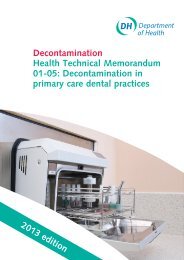A study of Patent Thickets (1.31Mb) - UK Intellectual Property Office
A study of Patent Thickets (1.31Mb) - UK Intellectual Property Office
A study of Patent Thickets (1.31Mb) - UK Intellectual Property Office
Create successful ePaper yourself
Turn your PDF publications into a flip-book with our unique Google optimized e-Paper software.
A Study <strong>of</strong> <strong>Patent</strong> <strong>Thickets</strong> 43<br />
Count <strong>of</strong> Triples<br />
0 1000 2000 3000 4000 5000<br />
Count <strong>of</strong> Triples<br />
by Main Area and Priority Year<br />
1980 1985 1990 1995 2000 2005<br />
Priority Year<br />
Electrical Eng. Instruments Chemistry<br />
Mechanical Eng. Civil Eng. & Others<br />
Count <strong>of</strong> triples by main technology area and priority year<br />
In an earlier version <strong>of</strong> this graph Graevenitz et al. (2012) show that the increases in triples are<br />
not affected by differential rates <strong>of</strong> patenting in the five main technology areas. We have checked<br />
that this also remains true when normalizing by the total weighted patent applications at EPO<br />
- compare Table 4.2 below.<br />
The ISI-OST-INPI technology classification (Schmoch, 2009) also allows us to further segment<br />
each main technology area into constituent technology areas. Below we document the evolution<br />
<strong>of</strong> the number <strong>of</strong> triples in three main technology areas by technology area, these are: Electrical<br />
Engineering (Figure 3), Instruments (Figure 4) and Chemistry (Figure 5)

















